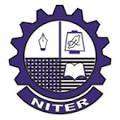National Institute of Textile Engineering and Research
National Institute of Textile Engineering and Research (Bengali: জাতীয় বস্ত্র প্রকৌশল ও গবেষণা ইনস্টিটিউট) is also known as NITER. Located in Savar, Dhaka District, it is one of the largest undergraduate textile engineering campus in Bangladesh. It offers the Bachelor of Science in Engineering degree in textile engineering, industrial and production engineering, fashion design and apparel engineering, computer science engineering andelectrical and electronic engineering in co-ordination with the University of Dhaka. The institute is a partnership between the Bangladesh Textile Mills Association (BTMA) and the Ministry of Textiles and Jute, Govt. of Bangladesh. It is a public-private partnership education and research organization and a constituent institute of the University of Dhaka.
জাতীয় বস্ত্র প্রকৌশল ও গবেষণা ইনস্টিটিউট - নিটার | |
 National Institute of Textile Engineering and Research - NITER | |
Other name | NITER |
|---|---|
Former name | Textile Industry Development Center (TIDC), NITTRAD |
| Type | Public–private partnership, Coeducational |
| Established | 1979 as TIDC and Transformed to current form in 2009 |
| Founder | Government of Bangladesh |
Academic affiliation | University of Dhaka |
| Chancellor | Abdul Hamid |
| Vice-Chancellor | Mohammad Akhtaruzzaman |
| Principal | Mohammed Mizanur Rahman |
| Dean | Md. Hasanuzzaman |
Academic staff | 90 |
| Students | 1300 |
| Undergraduates | 1300 |
| Address | Nayarhat, Kohinoor Gate , Savar , Dhaka District , 1350 , 23.9157°N 90.2356°E |
| Campus | Urban 17.7 acres (7.2 ha) |
| Language | English |
| Website | www |
History
In the late 1970s, the public textile mills under the Bangladesh Textile Mills Corporation (BTMC) were operating at a loss.[1] BTMC knew it needed skilled personnel to turn the mills around. To that end, and to serve the mills' testing and consulting needs, in 1979 it established a training institute at Savar, the Textile Industry Development Centre (TIDC).[1][2] For the first five years, the United Nations Development Programme (UNDP), through the United Nations Industrial Development Organization (UNIDO), supported infrastructure, curriculum development, and staff training at TIDC.[1][3]
In 1994 TIDC's name changed to National Institute of Textile Training Research and Design (NITTRAD). Later the Ministry of Textiles and Jute decided to run NITTRAD under public–private partnership (PPP) and handed over its operational management to Bangladesh Textile Mills Association (BTMA) under the Ministry of Textile and Jute. From 1 January 2013, the Ministry of Textiles and Jute, according to a suggestion from the University of Dhaka, changed the name of the institute to National Institute of Textile Engineering and Research. From 2010 to 2011 session NITER started Bachelor of Science in Textile engineering course under the University of Dhaka.
It also provides practical and training classes of textile engineering to students of private universities in Bangladesh.
Departments of NITER:
- B.Sc. in Textile Engineering(TE)
- B.Sc. in Industrial and Production Engineering (IPE)
- B.Sc. in Fashion Design and Apparel Engineering (FDAE)
- B.Sc. in Computer Science and Engineering (CSE)
- B.Sc. in Electrical and Electronics Engineering (EEE)
Collaboration
NITER has academic and research collaboration with following institutes:
- Wuhan Textile University, China
- University of Bolton, United Kingdom
- Hochschule Niederrhein, University of Applied Sciences, Germany
- UNIDO
- Deutsche Gesellschaft für Internationale Zusammenarbeit (GIZ)
References
- Maurer, Markus (2011). Skill Formation Regimes in South Asia. Peter Lang. pp. 334–335. ISBN 978-3-631-60020-7.
- Sawkat Jahangir, Md. (1998). "Chapter Five: Bangladesh Textile Mills Corporation (BTMC): An Overview". Causes and remedies of industrial sickness in Bangladesh (PhD). Aligarh Muslim University. p. 99. hdl:10603/52976.
- Volker, Rossbach; Frank Eckersley; El Sayed El Helw (25 July 1994). Work at the College of Textile Technology (Technical report). United Nations Industrial Development Organization. p. 17. Retrieved 28 July 2017.